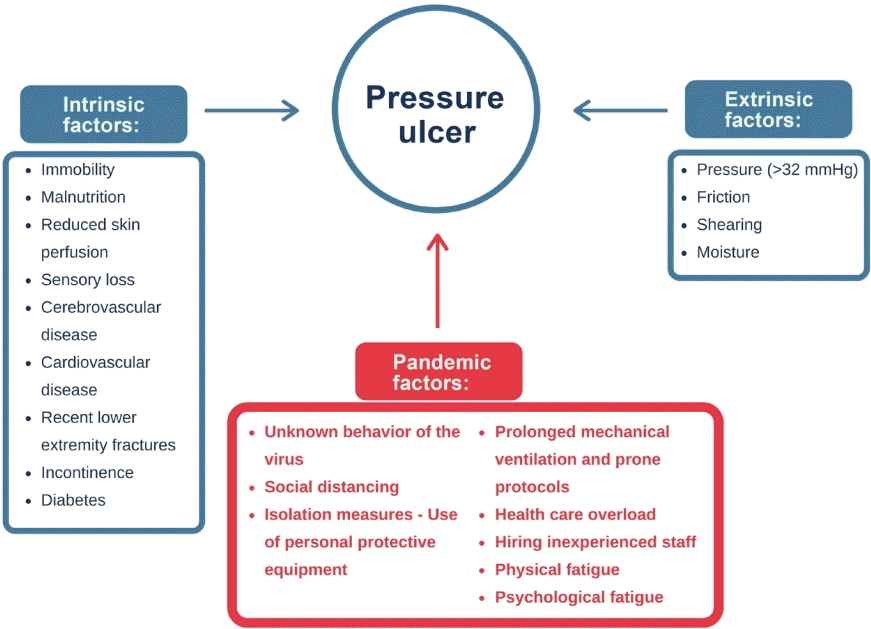Pressure ulcers: the last mile in the COVID-19 road
Article information
The coronavirus disease 2019 (COVID-19) pandemic has stretched the world's healthcare systems to their limits. There are many complications associated with COVID-19, but pressure ulcers (PUs) specifically occur in patients with prolonged hospitalization in the intensive care unit (ICU) who receive invasive mechanical ventilation (IMV). PUs are a frequent and silent enemy of patients, prolonging their hospital stay and increasing overall costs.
The global incidence of PUs is up to 42.2% of seriously ill patients with COVID-19 infection who are admitted to the ICU under IMV [1]. It is interesting to observe the distinctive distribution of PUs in patients with COVID-19, where up to 23.9% occur in areas put under pressure due to prone ventilation, for which the main risk factor is being on IMV in this position for 12 or more hours a day [2,3].
The complete treatment of PUs is extremely expensive, and can reach USD 561 a day considering medical supplies, surgical management, human resources, and the prolonged hospital stay, which affects the finances of healthcare centers [4].
At our center, between April 2020 to April 2021, a total of 19 patients required surgery, of whom 79% were men. Their average age was 60 years (range, 37–77 years). Patients who developed a grade III-IV PU required one to four surgical interventions, which consisted of surgical wound debridement (wound cultures, bursectomy, and ostectomy in case of osteomyelitis) to finally cover the lesions, which prolonged their hospitalization to approximately 25 days (range, 10–79 days) and generated extra costs of USD 788 a day. These PU cases meant an additional burden of USD 407,080 on the healthcare system during the first year of the pandemic at our institution.
The additional costs of this problem are related to both economic and psychological issues. Patients who recover from severe COVID-19 also face multiple intercurrent diseases, malnutrition, and muscle atrophy. When they finally reach some degree of muscular rehabilitation and ambulation and are in a better overall condition, the time has come to treat the PU. Hence, the final stretch of PU treatment adds approximately 3 more weeks to the hospital stay just when most of these patients feel that their hospital discharge is finally near. The impact of this extra time for recovery negatively affects the patient’s mood and disposition towards the proposed treatment plan. To deal with this important issue, our institution has developed a mental health monitoring protocol led by psychiatrists specializing in mood disorders to deal with the psychological impact of this last mile.
The main management of PUs is prevention. To ensure this, a multidisciplinary management system must be implemented, which involves doctors, nurses, nursing technicians, kinesiologists, and all health staff who participate in the patient care process. It has been observed that prevention is substantially cheaper than treatment, which costs between USD 3.2 and USD 104.5 a day (with between 79% and 85% of these costs allocated to human resources).
For adequate prevention programs, the risk factors for PU development must be identified, such as the intrinsic and extrinsic factors that have been classically described. However, in this pandemic we believe that additional factors must be considered (Fig. 1). At the beginning of the pandemic, there was fear on the part of the health staff to come into close contact with COVID-19 patients, and this probably resulted in a lower frequency of PU prevention maneuvers (e.g., changes in position and/or toileting). Subsequently, the staff faced multiple waves of patients, which were accompanied by work overload, physical and psychological fatigue, the development of burnout symptoms, the permanent use of personal protection equipment, and the hiring of inexperienced staff to be in charge of beds in ICUs [5], resulting in an increase in patients’ vulnerability.

Classic and pandemic-related factors influencing pressure ulcer development in the coronavirus disease 2019 pandemic
Adequate prevention of PUs must become a universal goal at healthcare centers, with a particular emphasis on care for the medical team, because its wear and tear in the current global context have taken medical personnel to the limit of their responsiveness. All this must be done in order to reduce the different risk factors that increase the natural progression of PUs and to develop a healing process free of intercurrent conditions, bringing patients closer to their desired, but not always expeditious return home, where they can reunite with their family and loved ones.
Notes
Conflict of interest
No potential conflict of interest relevant to this article was reported.
Ethical approval
This study was approved by the ethics committee of the Pontificia Universidad Católica de Chile (approval No. 200928010).
Author contribution
Conceptualization: E Ziede, R Tejos, M Olivera, S Searle. Data curation: E Orellana. Methodology: R Tejos. Visualization: R Tejos. Writing - original draft: E Ziede, E Orellana. Writing - review & editing: E Ziede, E Orellana, R Tejos, S Searle.
